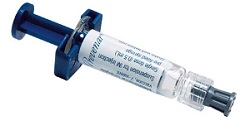 Fever is a common side effect of many vaccinations, with the Centers for Disease Control and Prevention estimating that one-third of people receiving Pfizer's ($PFE) Prevnar 13 develop a mild case. Flu vaccines also cause cases, prompting researchers to investigate a question--does giving the shots simultaneously raise the risk of fever?
Fever is a common side effect of many vaccinations, with the Centers for Disease Control and Prevention estimating that one-third of people receiving Pfizer's ($PFE) Prevnar 13 develop a mild case. Flu vaccines also cause cases, prompting researchers to investigate a question--does giving the shots simultaneously raise the risk of fever?
The resulting study suggests the answer is yes. Writing in JAMA Pediatrics, the researchers reported asking the parents of 530 children to send a text with their kid's temperature each evening for a week following vaccination in order to assess the likelihood of developing a fever of 100.4°F (38°C) or higher after receiving a trivalent flu vaccine or Prevnar 13. Fewer than 10% of kids who received just one of the vaccines developed a fever in the first day after being immunized, but the risk rose significantly when both doses were given simultaneously.
More than one-third of children who were given both vaccines developed a fever by the night after being immunized. This translates into around 20 extra cases of fever per 100 vaccinations compared to just receiving either the flu shot or Prevnar 13. The finding corroborates warnings on the CDC website that advise parents of children who have previously had seizures to talk to their doctor before giving Prevnar 13 and the flu vaccine together. The resulting fever can cause febrile seizures, a relatively common, normally harmless type of fit.
While fevers and particularly febrile seizures are distressing for children and their parents, the risk of long-term harm is minimal. The benefits of being protected against influenza and pneumococcus far outweigh the risks. The study also has several weaknesses that could affect the reliability of the data. No randomization occurred, the study took place over a single flu season and the participants were mainly urban Latinos. It is unclear whether the findings would be the same for other populations and different flu seasons.
- here's the JAMA Pediatrics abstract
- read MedPage Today's coverage
- view the study outline